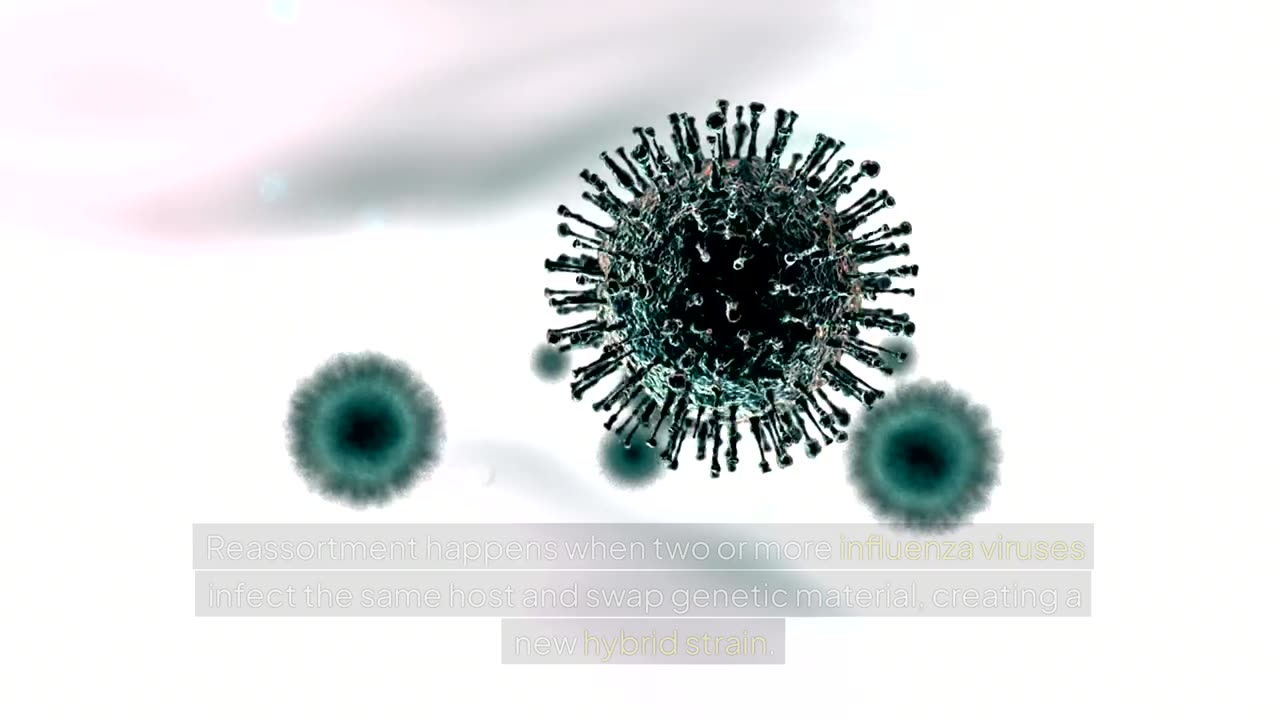Premium Only Content

H5N9 vs. H5N1: Understanding the Differences After the California Bird Flu Outbreak**
**H5N9 vs. H5N1: Understanding the Differences After the California Bird Flu Outbreak**
---
### **Intro: A New Bird Flu Strain in the Spotlight**
Imagine waking up to headlines about a new strain of bird flu spreading on American farms. Panic sets in—how dangerous is it? Is this the next big pandemic? Recently, a California duck farm reported cases of H5N9, a strain of bird flu many people have never heard of. But how does it compare to H5N1, the strain that has been causing widespread outbreaks in birds, cattle, and even some humans? Understanding the key differences between these viruses can help us grasp what this means for public health, food safety, and the risk of another outbreak in humans. Let’s break it all down.
---
### **1. What Are H5N9 and H5N1?**
**Hook:** What’s in a name? These bird flu strains may sound similar, but they’re not identical twins.
H5N9 and H5N1 are both subtypes of the avian influenza virus (AIV), named after their hemagglutinin (H) and neuraminidase (N) proteins. These proteins determine how the virus interacts with birds and, in some cases, mammals, including humans.
- **H5N1:** This strain has been the dominant cause of bird flu outbreaks worldwide, including the recent surge in the U.S. It has spread among wild birds, poultry, cattle, and even humans, with at least 67 reported cases.
- **H5N9:** This strain has been detected in birds before but was previously considered a low-pathogenic virus, meaning it caused mild illness. However, the recent outbreak in California showed that H5N9 had evolved into a highly pathogenic strain, capable of causing severe disease and high mortality in poultry.
Both strains belong to the H5 lineage of avian flu, but their genetic makeup and behavior can differ significantly, influencing their impact on bird populations and their potential threat to humans.
---
### **2. How Did H5N9 Appear in California?**
**Hook:** A genetic mix-up inside a duck might have led to the emergence of this new H5N9 strain.
Scientists believe H5N9 didn’t just appear out of nowhere—it was the result of a **reassortment event.** Reassortment happens when two or more influenza viruses infect the same host and swap genetic material, creating a new hybrid strain.
- In this case, researchers suspect that H5N9 resulted from H5N1 mixing with other influenza viruses inside a duck. Ducks are known “mixing vessels” for flu viruses, meaning they can host multiple strains at once and facilitate genetic reshuffling.
- The World Organization of Animal Health reported that both H5N9 and H5N1 were found in sick ducks at the California farm, confirming that these viruses were co-circulating.
While reassortment is common in avian flu viruses, not all new strains become widespread threats. However, this evolution highlights how rapidly bird flu can change, keeping scientists and health officials on high alert.
---
### **3. Is H5N9 More Dangerous Than H5N1?**
**Hook:** Is this the beginning of a new public health crisis, or just another minor flu variant?
Right now, H5N9 does not appear to be more dangerous than H5N1, but that doesn’t mean it’s harmless. Here’s what we know so far:
- **Severity in birds:** H5N9 has now been classified as “highly pathogenic,” meaning it can cause serious illness and death in poultry. This is similar to H5N1, which has led to massive bird cullings worldwide.
- **Human infections:** Unlike H5N1, which has infected humans on multiple occasions, H5N9 has not yet been reported in people. However, experts warn that continued mutations could eventually allow it to jump to humans.
- **Immunity concerns:** Since most people have not been exposed to H5N9, our immune systems may not recognize it as well as H5N1, potentially increasing its risk if it ever starts spreading among humans.
While H5N9 hasn’t proven to be an immediate public health threat, ongoing surveillance is crucial to detect any concerning changes.
---
### **4. Could H5N9 Lead to Another Pandemic?**
**Hook:** How close are we to another global flu crisis? Let’s examine the risk factors.
For a bird flu strain to cause a human pandemic, it needs three key abilities:
1. **Efficient transmission between humans.**
2. **Severe illness in people.**
3. **Resistance to existing immunity or treatments.**
At this stage, H5N9 does not meet these criteria, making a pandemic unlikely. However, flu viruses evolve rapidly, and continued outbreaks in birds create opportunities for new mutations.
Factors that could increase the risk of a pandemic include:
- **Increased human exposure to infected birds.**
- **Mutations that allow the virus to bind more easily to human cells.**
- **Resistance to antiviral medications.**
The CDC and WHO are monitoring H5N9 closely, ensuring that if it begins adapting to humans, we can respond quickly.
---
### **5. How Can We Prevent the Spread of Bird Flu?**
**Hook:** Can simple actions protect us from a potential outbreak?
While H5N9 isn’t a human health threat yet, preventing its spread among birds is crucial to reducing future risks. Here’s how governments, farmers, and individuals can help:
- **Farm biosecurity:** Poultry farms should implement strict biosecurity measures, such as controlling farm access, disinfecting equipment, and keeping birds away from wild waterfowl.
- **Wildlife surveillance:** Monitoring wild bird populations can help detect new flu strains before they reach farms.
- **Culling and vaccination:** When outbreaks occur, culling infected flocks helps stop the spread. Some countries are also testing bird flu vaccines to protect poultry.
- **Human precautions:** People who work with birds, such as farmworkers and veterinarians, should wear protective gear and follow hygiene protocols.
Public awareness and responsible farming practices play a huge role in keeping bird flu under control.
---
### **Outro: Stay Informed and Join the Conversation**
The emergence of H5N9 in California is a reminder that bird flu continues to evolve, presenting new challenges for farmers, scientists, and public health officials. While this strain doesn’t currently pose a major threat to humans, its rapid reassortment with H5N1 highlights the unpredictable nature of influenza viruses.
Want to stay updated on the latest health and science news? Be sure to **like, comment, and subscribe** for more breakdowns of the biggest medical and scientific developments. Have questions about bird flu or other viral outbreaks? Drop them in the comments below! Let’s keep the conversation going.
---
-
 17:51
17:51
Stephen Gardner
7 hours ago🔥YES!! Trump CUTS CORD on Democrats SECRET PROGRAM!
68.8K54 -
 2:16:49
2:16:49
TheSaltyCracker
7 hours agoMusk Destroys Gov't Money Pot ReeEEeE Stream 02-05-25
130K229 -
 1:10:59
1:10:59
FreshandFit
6 hours agoTop 3 Ways To Overcome A Break Up
74K7 -
 6:32:11
6:32:11
Akademiks
7 hours agoDrake Finally CUTS off FAKE FRIENDS in the Industry. VIOLATES KHALED, LEBRON! Announces album Feb14
60.5K11 -
 27:28
27:28
Glenn Greenwald
11 hours agoGlenn Reacts to Trump's Gaza Take Over: System Update Special
174K285 -
 2:13:49
2:13:49
Melonie Mac
7 hours agoGo Boom Live Ep 36!
92.5K10 -
 1:02:11
1:02:11
Sarah Westall
7 hours agoFreezing USAID & its Operations in Ukraine: A Massive Money Laundering Organization? w/ Sam Anthony
80.2K17 -
 2:05:35
2:05:35
Space Ice
11 hours agoSpace Ice & Redeye: Neil Breen's Pass Thru
34.5K1 -
 1:00:23
1:00:23
The StoneZONE with Roger Stone
7 hours agoRoger Stone Talks Trump’s Electric First 100 Day Agenda | The StoneZone w/ Roger Stone
36.8K8 -
 DVR
DVR
Redacted News
10 hours agoBREAKING! EPSTEIN LIST INCOMING UNDER AG PAM BONDI? DEMOCRATS FREAKING OUT, PRINCE ANDREW NERVOUS
188K262